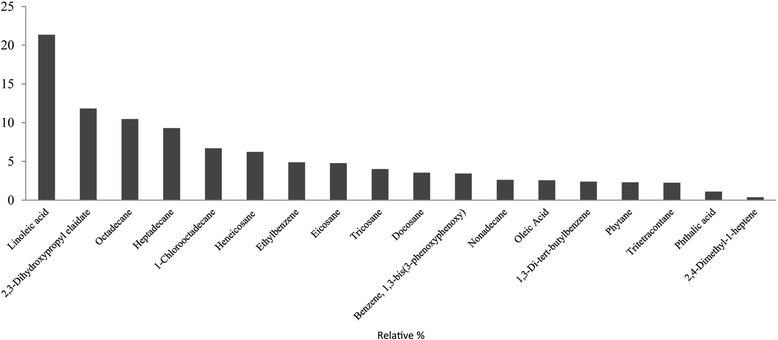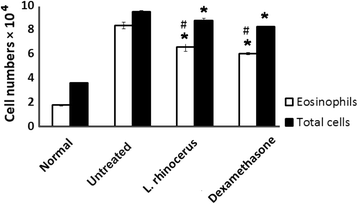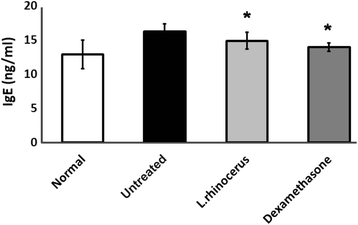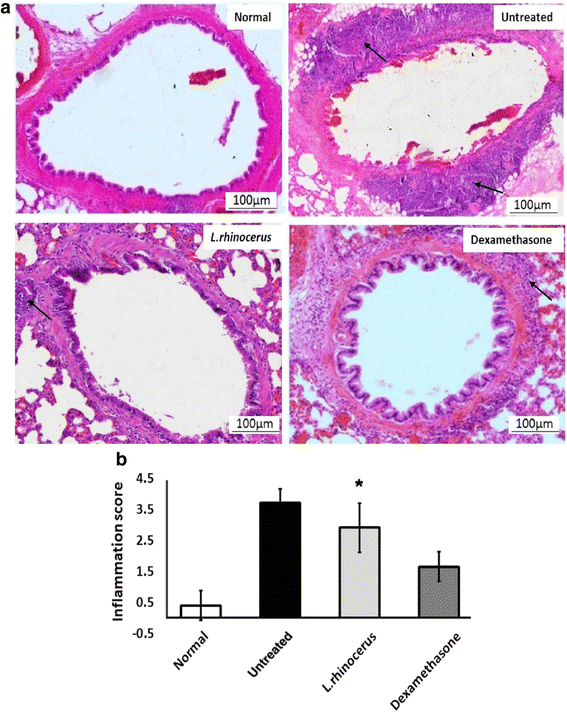Phytochemical profiles and inhibitory effects of Tiger Milk mushroom (Lignosus rhinocerus) extract on ovalbumin-induced airway inflammation in a rodent model of asthma
- PMID: 27255587
- PMCID: PMC4891846
- DOI: 10.1186/s12906-016-1141-x
Phytochemical profiles and inhibitory effects of Tiger Milk mushroom (Lignosus rhinocerus) extract on ovalbumin-induced airway inflammation in a rodent model of asthma
Abstract
Background: Lignosus rhinocerus (L. rhinocerus), which is known locally as Tiger Milk mushroom, is traditionally used in the treatment of asthma by indigenous communities in Malaysia. However, to date, its efficacy on asthma has not been confirmed by scientific studies and there is also sparse information available on its active constituents. In this study, the volatile constituent of L. rhinocerus hot water extract was investigated using gas chromatography mass spectrometry (GC-MS). The potential effects of L. rhinocerus extract for anti-asthmatic activity was further investigated on ovalbumin (OVA)-sensitized asthmatic Sprague Dawley rats.
Methods: Sequential extraction using five solvents (petroleum ether, diethyl ether, hexane, ethyl acetate and methanol) was conducted prior to GC-MS analysis. Male Sprague Dawley rats were divided into the following four groups of five animals each: 1) normal rats, 2) sensitization plus OVA-challenged rats 3) sensitization plus OVA-challenged with L. rhinocerus treatment and 4) sensitization plus OVA-challenged with dexamethasone treatment. The levels of immunoglobulin E (IgE) in the serum and T-helper 2 cytokines, including interleukin (IL)-4, IL-5 and IL-13, in bronchoalveolar lavage fluid (BALF), as well as eosinophil infiltration in the lungs, were investigated.
Results: GC-MS analysis revealed the presence of five main groups (alkane, fatty acids, benzene, phenol and dicarboxylic acid) with a total of 18 constituents. Linoleic acid (21.35 %), octadecane (11.82 %) and 2,3-dihydroxypropyl elaidate (10.47 %) were present in high amounts. The extract significantly ameliorated the increase in total IgE in serum and IL-4, IL-5 and IL-13 levels in BALF and also effectively suppressed eosinophils numbers in BALF while attenuating eosinophil infiltrations in the lungs.
Conclusion: L. rhinocerus hot water extract has the potential to be used as an alternative for the treatment of acute asthma.
Keywords: Airway inflammation; Asthma; GC-MS; Lignosus rhinocerus; Linoleic acid; Tiger milk mushroom.
Figures






Similar articles
-
Preclinical toxicological evaluations of the sclerotium of Lignosus rhinocerus (Cooke), the Tiger Milk mushroom.J Ethnopharmacol. 2013 May 2;147(1):157-63. doi: 10.1016/j.jep.2013.02.027. Epub 2013 Feb 28. J Ethnopharmacol. 2013. PMID: 23458920
-
Evaluation of the sub-acute toxicity of the sclerotium of Lignosus rhinocerus (Cooke), the Tiger Milk mushroom.J Ethnopharmacol. 2011 Oct 31;138(1):192-200. doi: 10.1016/j.jep.2011.09.004. Epub 2011 Sep 10. J Ethnopharmacol. 2011. PMID: 21930194
-
Bu-Shen-Yi-Qi formulae suppress chronic airway inflammation and regulate Th17/Treg imbalance in the murine ovalbumin asthma model.J Ethnopharmacol. 2015 Apr 22;164:368-77. doi: 10.1016/j.jep.2015.01.016. Epub 2015 Jan 24. J Ethnopharmacol. 2015. PMID: 25625352
-
Ethnomedicinal uses, pharmacological activities, and cultivation of Lignosus spp. (tiger׳s milk mushrooms) in Malaysia - A review.J Ethnopharmacol. 2015 Jul 1;169:441-58. doi: 10.1016/j.jep.2015.04.042. Epub 2015 Apr 30. J Ethnopharmacol. 2015. PMID: 25937256 Review.
-
The Wound Healing Potential of Lignosus rhinocerus and Other Ethno-myco Wound Healing Agents.Mycobiology. 2023 Jan 23;51(1):1-15. doi: 10.1080/12298093.2022.2164641. eCollection 2023. Mycobiology. 2023. PMID: 36846625 Free PMC article. Review.
Cited by
-
Chemical Analysis of SU-Eohyeol Pharmacopuncture and Its In Vitro Biological Activities.Int J Med Sci. 2024 Oct 3;21(13):2562-2577. doi: 10.7150/ijms.100083. eCollection 2024. Int J Med Sci. 2024. PMID: 39439454 Free PMC article.
-
Clinical efficacy of recombinant human latrophilin 3 antibody in the treatment of pediatric asthma.Exp Ther Med. 2018 Jan;15(1):539-547. doi: 10.3892/etm.2017.5376. Epub 2017 Oct 25. Exp Ther Med. 2018. PMID: 29375702 Free PMC article.
-
Intranasal administration of Lignosus rhinocerotis (Cooke) Ryvarden (Tiger Milk mushroom) extract attenuates airway inflammation in murine model of allergic asthma.Exp Ther Med. 2019 May;17(5):3867-3876. doi: 10.3892/etm.2019.7416. Epub 2019 Mar 20. Exp Ther Med. 2019. PMID: 30988772 Free PMC article.
-
A Status Review of the Bioactive Activities of Tiger Milk Mushroom Lignosus rhinocerotis (Cooke) Ryvarden.Front Pharmacol. 2018 Jan 15;8:998. doi: 10.3389/fphar.2017.00998. eCollection 2017. Front Pharmacol. 2018. PMID: 29379443 Free PMC article. Review.
-
Lignosus rhinocerotis extract ameliorates airway inflammation and remodelling via attenuation of TGF-β1 and Activin A in a prolonged induced allergic asthma model.Sci Rep. 2023 Oct 27;13(1):18442. doi: 10.1038/s41598-023-45640-z. Sci Rep. 2023. PMID: 37891170 Free PMC article.
References
-
- World Health Organization (WHO) Asthma fact sheet. 2013.
MeSH terms
Substances
LinkOut - more resources
Full Text Sources
Other Literature Sources
Medical
Miscellaneous

